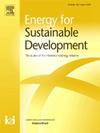从凋落物到能源:碱预处理对禽畜凋落物产气及沼液特性的影响
IF 4.9
2区 工程技术
Q2 ENERGY & FUELS
引用次数: 0
摘要
为了保护自然资源,减轻化石燃料对环境的危害,以及应对能源短缺和燃料成本上升等挑战,从各种有机基质中生产沼气已经在全球范围内得到了广泛的研究。家禽粪便就是这样一种有机基质,有可能用于生产沼气。肉仔鸡窝产粪的厌氧消化是指在受控环境条件下与碳质基质共同消化;然而,在野外条件下,以肉鸡粪为主要基质进行大规模生产的研究较少。在本试验中,采用碱预处理的方法,在不添加其他共基质的情况下产生更多的沼气。分别给予无碱预处理(B0)、碱预处理@ 0.1 mol/L (B1)和碱预处理@ 0.2 mol/L (B2) 3种处理。所有处理的初始和日有机负荷率(OLR)分别保持在25.40 gVS/L和1.06 gVS/L,这是由于稀释率为1:10和消化池体积相似。结果表明:水力滞留时间(HRT) B1组最低(28 d), B2组次之(40 d),对照组最低(51 d)。B1的平均日产气量最高(0.0186 m3), B2次之(0.0105 m3), B0次之(0.0013 m3)。B2产甲烷量最高的处理和日产甲烷量也存在显著差异,但B1的日平均产甲烷量显著高于B2。分析消化后的禽窝料浆液显示显著(P <;0.01)不同处理和天数的理化特征和近似成分差异。综上所述,@ 0.1 mol/L的碱预处理提高了禽肉废弃物的产气潜力,处理后得到的沼液可作为肥料利用。这项研究通过实现有效的废物管理和可再生能源的产生,为家禽业提供了一个可持续的解决方案。本文章由计算机程序翻译,如有差异,请以英文原文为准。
From litter to energy: Effect of alkali pretreatment on biogas production from poultry litter and slurry characteristics
Biogas production from various organic substrates has been extensively studied globally, to conserve natural resources, mitigate environmental harm associated with fossil fuels, and address challenges such as energy scarcity and escalating fuel costs. Poultry litter is one such organic substrate that has the potential for use in biogas production. Anaerobic digestion of broiler litter involves co-digestion with carbonaceous substrates under controlled environmental conditions; however, production using broiler litter as the main substrate on a large scale under field conditions has been less studied. In the present experiment, alkali pretreatment of poultry litter was carried out to produce a higher quantity of biogas without any other co-substrate. Three treatments were given as no alkali pretreatment (B0), alkali pretreatment @ 0.1 mol/L (B1), and 0.2 mol/L (B2). The initial and daily organic loading rate (OLR) was kept at 25.40 gVS/L and 1.06 gVS/L, respectively, in all treatments due to a similar dilution rate of 1:10 and digester volume. Results showed that Hydraulic Retention Time (HRT) was lowest in B1 (28 days) followed by B2 (40 days) and then in control (B0) (51 days). B1 had the highest average daily biogas yield (0.0186 m3), followed by B2 (0.0105 m3), and then B0 (0.0013 m3). The composition of biogas also varied significantly between days as well as treatments with the highest methane percent in B2, but the average daily methane yield was significantly higher in B1. Analysis of digested poultry litter slurry revealed significant (P < 0.01) differences in physico-chemical characteristics and proximate composition across treatments and days. It was concluded that alkali pretreatment @ 0.1 mol/L enhances the biogas production potential of poultry litter and slurry obtained along can be utilized as fertilizer. This study offers a sustainable solution for the poultry industry by enabling efficient waste management and renewable energy generation.
求助全文
通过发布文献求助,成功后即可免费获取论文全文。
去求助
来源期刊

Energy for Sustainable Development
ENERGY & FUELS-ENERGY & FUELS
CiteScore
8.10
自引率
9.10%
发文量
187
审稿时长
6-12 weeks
期刊介绍:
Published on behalf of the International Energy Initiative, Energy for Sustainable Development is the journal for decision makers, managers, consultants, policy makers, planners and researchers in both government and non-government organizations. It publishes original research and reviews about energy in developing countries, sustainable development, energy resources, technologies, policies and interactions.
 求助内容:
求助内容: 应助结果提醒方式:
应助结果提醒方式:


